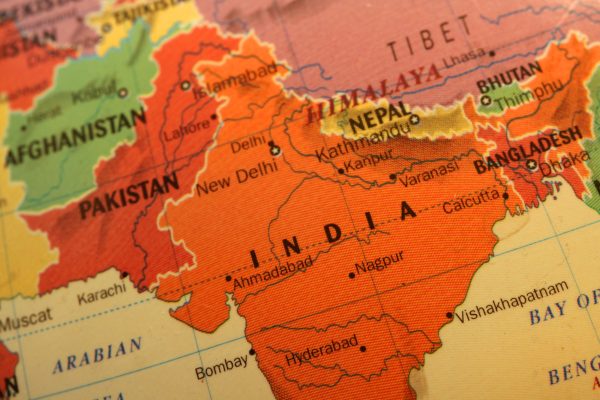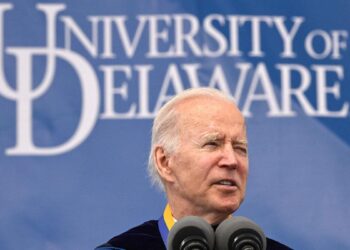India is in the global limelight as it takes on the presidency of the G-20 and completes a two-year stint on the United Nations Security Council. It also took over the presidency of the Shanghai Cooperation Organization in September, the same month it hosted a meeting of senior Quad officials.
However, it is important to recognize that we have been here before. The world was touting India’s moment during the economic liberalization under Prime Minister Narasimha Rao (1991-96), the bolder foreign policy of Prime Minister Atal Bihari Vajpayee (1998-2004), and the country’s near double-digit growth during the early years of Prime Minister Manmohan Singh (2004-14).
Much of the reason for India being unable to live up to its global potential is that economic reform has historically been the weakest link of New Delhi’s external engagement. While India escaped the shackles of the infamous “Hindu rate of growth” in the post-Cold War period, it continued to face an equally cumbersome “Indian rate of policymaking” rooted in problems of bureaucratic inertia and poor inter-ministerial coordination.
In this context, a reality check is required: Does the rhetoric of India’s foreign policy aspirations match the reality of the country’s domestic reform momentum?
Case of India’s “Look East”/ “Act East” Policy
There is no better example of this than India’s “Look East” policy (which was renamed “Act East” in 2014). The “Look East” policy was launched in the early 1990s as part of an effort to elevate the importance of Southeast Asia (and later East Asia and the broader Indo-Pacific region) in India’s foreign policy priorities.
However, India’s regional integration has always been contingent on the pace of the country’s domestic reform agenda. For example, barriers in strengthening infrastructure connectivity at home prevented India from fully leveraging its geographic proximity and historical linkages with Southeast Asia. This has been illustrated by the contrast between the rhetoric of India’s Northeast being labeled the “natural gateway for India to Southeast Asia and beyond” and the reality of delays in completing key infrastructure projects connecting India and Southeast Asia, such as the Trilateral Highway Project and the Kaladan Multi-Modal Transit Transport Project.
A recurring challenge over the course of the “Look East” policy was regional powers questioning India’s ability to sustain its growth and reform momentum. This prompted the initial decision by ASEAN to grant India sectoral rather than full dialogue partner status in 1992. Undergirding this was a perception that while India had implemented first generation reforms – which reduced import duties, removed export restrictions, and permitted currency convertibility – the second wave of economic liberalization – focused on addressing structural issues, including infrastructure deficiencies and a difficult regulatory climate with respect to such issues as land acquisition, labor market deregulation, and the disinvestment (privatization) of public-sector undertakings (state-owned enterprises) – remained slow-moving. A related concern was if India’s economic liberalization was losing momentum following a string of short-lived and unstable governments in New Delhi in the mid-1990s.
India’s status in the region suffered a further blow during the Asian Financial Crisis in 1997-99, which slowed the country’s economic engagement with the region. This came as the devaluation of several regional currencies plagued by the contagion effect of foreign capital outflows undermined the competitiveness of Indian exports to Southeast Asia. The fact that India had been largely shielded from the crisis due to restrictions on capital account convertibility also demonstrated that its economy remained relatively detached from regional supply chains and transnational production networks.
The Asian Financial Crisis had a lasting impact on the “Look East” policy. In its aftermath there was a growing emphasis on strengthening regional economic integration, which led to the emergence of new initiatives from which India was excluded, such as the ASEAN+3 in 1997 and Chiang Mai Initiative currency swap agreement in 1999. The regional architecture came to be regarded as a set of concentric circles with ASEAN at the center; China, Japan, and South Korea (the +3) formed part of the inner circle or primary regional partners of ASEAN, while India was seen as part of the outer circle or a second tier country in the regional architecture.
Moreover, despite the government projecting a more investor-friendly image since India’s economic liberalization in the 1990s, the country’s historically protectionist and conservative economic policies remain well entrenched. This has been reflected in the slow pace of trade negotiations with neighboring countries. India-ASEAN trade targets of $100 billion in 2015 and $200 billion in 2022 have also been missed. Relative to other powers, India’s level of regional economic integration with ASEAN remains modest, particularly in the areas of strengthening trade and connectivity.
New Delhi’s decision to exit the Regional Comprehensive Economic Partnership (RCEP) free-trade agreement in 2019 reaffirms the link between India’s domestic reform momentum and its eastward engagement. The decision was partially driven by concerns that Indian industries could not compete with their Asian (and particularly Chinese) counterparts. While India has recently concluded bilateral trade agreements with Australia and the United Arab Emirates, it maintains an aversion to multilateral agreements. Aside from India’s limited appetite for rejoining the RCEP, this has been evidenced by New Delhi’s absence from the trade pillar of the U.S.-led Indo-Pacific Economic Framework (IPEF) that India joined in June.
India will need to overcome these impediments if it is to upgrade its status from a secondary to primary player in the regional architecture.
Tailwinds
Where does India stand today in terms of its economic outlook? It is projected to be among the world’s fastest growing major economies, with the World Bank recently upgrading the country’s 2023 GDP growth forecast from 6.5 percent to 6.9 percent. It surpassed the United Kingdom this year to emerge as the world’s fifth largest economy and is set to overtake Germany as the world’s fourth largest economy by 2027. This contrasts with China, where the World Bank has forecast that the country’s growth will be slower than the rest of the region for the first time in three decades.
India also maintains a demographic dividend with a population that will overtake China as the world’s most populous country in 2023, according to the United Nations. This is supplemented by a large pool of IT professionals, vast digital ecosystem, and legislation aimed at leveraging these strengths. This includes a new draft Digital Data Protection bill that was introduced in November after the previous draft came under criticism over the compliance burden of its data localization provisions. This is one of several pieces of legislation aimed at supporting India’s digital economy, including the Telecom Bill and an upcoming Digital India Act. Technology solutions such as the Aadhaar card have also been used to strengthen India’s social welfare system.
India is also a beneficiary of the push to decouple and diversify supply chains away from China amid the persistence of (and now chaotic exit from) Beijing’s zero-COVID policy and geopolitical tensions with the United States. A key example is the decision by Apple to build its latest iPhone model in India. So is the push to establish or expand supply chains in India for other critical and emerging technologies, ranging from semiconductors (particularly in the area of chip design) to hydrogen (where India is emerging as an important electrolyzer producer) and ammonia (where India is the world’s third-largest manufacturer).
Recognition of India’s growing strategic importance has been reflected in the establishment of the EU-India Trade and Technology Council – the second country (after the United States) with which the EU has established such a forum – as well as India’s participation in the Supply Chain Resilience Initiative that seeks to diversify supply chains away from China.
These developments have been supported by Modi’s “Make in India” and “Atmanirbhar Bharat” (self-reliant India) campaigns, which aim to strengthen the resilience and competitiveness of Indian industries. There has also been a rapid acceleration in infrastructure development under the Modi government as it has fast-tracked several high-profile projects that had been languishing under previous governments.
Interestingly, this infrastructure push is also taking place in non-BJP-ruled states as good governance has come to be seen as a vote winner. This has been facilitated by government support schemes, such as production-linked incentives, which supports the development of national champions in strategically important sectors and the Gati Shakti National Masterplan for multi-modal connectivity, which aims to improve last-mile infrastructure connectivity.
Headwinds
However, notwithstanding these achievements, the hype can often outweigh the substance. For example, on semiconductors India will be making older generation chips (known as trailing-edge semiconductors) rather than the most advanced chips. The fact that chip-making requires large amounts of water and energy is also a challenge for India as it remains prone to droughts and power shortages. Similarly, while India is projected to have the fastest global growth in solar module capacity expansion, the country’s local solar manufacturing capacity remains limited despite the government imposing hefty duties on solar module and cell imports.
Beyond this, India faces several political and structural challenges. While Modi is committed to economic liberalization, the ideology of his party (the Hindu nationalist BJP and its sister organizations in the Sangh Parivar) is economically nationalist and Marxist at heart. Whether India’s reform momentum can be sustained beyond Modi’s tenure remains to be seen. Modi plans to stand for (and is likely to win) a third term in 2024, but what happens beyond that remains unclear.
Meanwhile, economic disparities remain significant. In India’s federal system, development cannot be seen through the prism of one country but 28 separate states that maintain differing regulations on such issues as labor and land acquisition. These regional disparities have been partially addressed through legislation such as the Goods and Services Tax (GST), which aims to create a single unified market in India. A growing emphasis on competitive federalism has also prompted states to compete with each other on ease of doing business rankings in order to attract investment. However, there remain other disparities, such as between the formal and informal economy and a well-entrenched urban-rural divide that will not be easily overcome.
Modi’s Moment
India is in the midst of a period of strategic opportunity given its centrality to several key global debates. This became evident following the Russian invasion of Ukraine, as India was courted by countries on both sides of the conflict. This served to vindicate India’s longstanding commitment to strategic autonomy in its foreign policy, which has been emulated by other emerging economies that have refused to take sides in the conflict. Rather than a bipolar international system revolving around the China-U.S. relationship, the emerging global order is likely to be more polycentric or multipolar with middle powers and aspiring global powers such as India holding more agency.
Climate change will also be a key focus area during India’s presidency of the G-20 as it seeks to emphasize issues of climate justice and financing. Modi’s Mission LiFE (Lifestyle for Environment) program will promote sustainability and a circular economy. There is also a proposal for an International Biofuels Alliance, which parallels India’s previous role in spearheading the International Solar Alliance.
India’s G-20 presidency is also well-timed as it coincides with Japan holding the G-7 presidency, which will allow for improved coordination between two of Asia’s leading democracies on issues of global governance. India’s G-20 presidency also forms part of a troika of G-20 presidencies, comprising Indonesia, India, and Brazil, which will elevate the voice of the Global South.
However, statements can often outweigh the substance. There are two prominent examples of this: India’s self-proclaimed status as the “world’s pharmacy” during the COVID-19 pandemic was derailed by the devastating impact of the Delta variant in 2021, which prompted the country to halt vaccine exports. Similarly, claims that India would “feed the world” after grain exports from Ukraine were disrupted by the Russian invasion were once again derailed when New Delhi imposed a ban on wheat exports.
India’s emergence as a global power remains in its infancy. Despite claims that China has lost its status as an engine of global growth, India is not yet in a position to replace China (as India accounts for 7 percent of global GDP compared to 18 percent for China). Supply chains remain sticky, and China will remain central to global supply chains and transnational production networks for the foreseeable future.
As noted, the greatest risk to India’s global aspirations lies at home. In this context, it may be prudent for India to take a page out of China’s book (prior to the era of “wolf warrior” diplomacy) by adopting elements Deng Xiaoping’s dictum of “biding time and maintaining a low profile.” This means that India will need to speak softly and carry a big stick in sustaining and accelerating its reform momentum.
Read the full article here

















